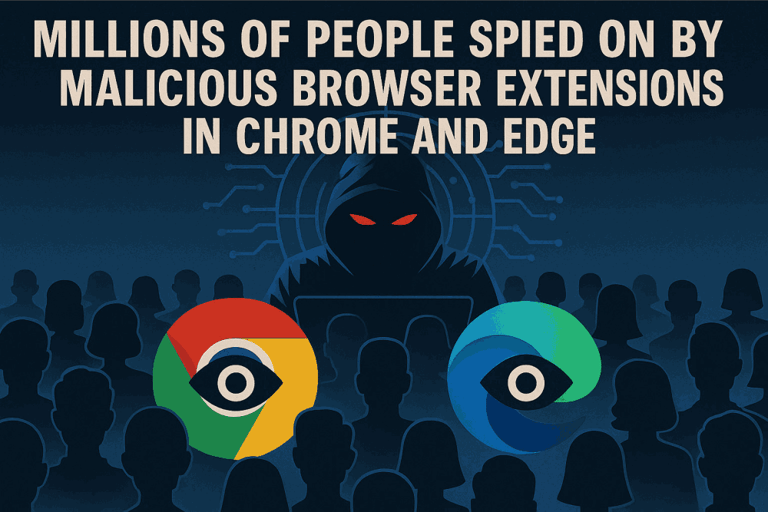Malicious Edge & Chrome Extensions Exposed
Discover the invisible threat lurking in millions of Edge & Chrome Extensions. Researchers reveal how over 2 million users unknowingly risk their privacy with malicious extensions disguised as helpful tools. Stay informed about the dangers of browser extensions and protect your online behavior.
CYBER SECURITY THREAT
4 min read
Millions Spied on by Malicious Edge and Chrome Extension
🌐 The Invisible Threat Behind Edge and Chrome Extensions
Millions of users unknowingly put their privacy at risk every day simply by using browser extensions in Chrome and Edge. Researchers have discovered a campaign that tracked users’ online behavior using 18 different Chrome extensions available officially in Edge and Chrome webstores. The total number of installs is estimated to be more than a mind boggling 2,000,000.
What seems like a convenient productivity booster Chrome Extensions or a helpful tool could, in fact, be a silent intruder. Cybersecurity researchers have uncovered several malicious extensions disguised as shopping assistants, PDF converters, or coupon apps—harvesting users’ browsing data, tracking online behavior, and even capturing login credentials. These extensions often make it past browser store security checks by initially behaving normally, only to activate hidden malicious functions after installation. Once granted permissions, they may monitor visited websites, hijack search results, redirect traffic, inject ads, or worse—send sensitive data to remote servers controlled by threat actors.
🕵️♀️ Extent of Malicious Chrome Extensions
Recent investigations revealed that over 20 million Edge and Chrome Extensions were affected by such spyware-like extensions. In one case, extensions linked to a broader surveillance operation were found intercepting data for advertising fraud or profiling users for other illicit purposes. Even enterprise environments weren't spared, with some malicious tools infiltrating employee devices and compromising organizational security.
🔒 Protect Yourself from Edge and Chrome Extension Based Spying
Here’s how you can safeguard your digital life from these Edge and Chrome Extension stealthy invaders:
Audit Your Edge and Chrome Extensions
Regularly review and remove unnecessary or suspicious Edge and Chrome extensions. If you don’t remember installing one or its permissions seem excessive, uninstall it immediately.
Check Chrome Extension Permissions
Before installing an Edge or Chrome Extensions, inspect what an extension can access. Be wary of any that request permission to "read and change all your data on the websites you visit."
Download Only from Trusted Sources
Stick to verified edge and chrome extensions from reputable developers, and read user reviews and update histories carefully. Be cautious even in official stores—bad actors can slip through the cracks.
Update Your Browser Frequently
Browser developers patch vulnerabilities and improve extension security regularly. Keep your Chrome or Edge updated to the latest version.
Use Security Software
Install reliable Antivirus like VIPRE which does everything a big antivirus can do without the bloatware and at a fraction of the price. Also use browser-specific security tools that can detect and block shady extensions or Phishing attempts.
Enable Site Permissions Cautiously
Consider adjusting site settings so that edge or chrome extensions only activate on specific websites you trust—not across all your browsing sessions.
Educate Yourself and Your Team
In workplaces, promote cybersecurity awareness and establish policies for approved browser extensions.
Long Term Effects - Edge/ Chrome Extensions
💡 The convenience of browser extensions can come at a steep cost if vigilance is ignored. Treat every edge and chrome extensions like a potential gateway to your privacy. With mindful usage and proactive safeguards, you can enjoy the productivity benefits of Chrome and Edge, without letting cybercriminals peek through the cracks. The long-term effects of using malicious browser like edge and chrome extensions can be far more damaging than most users realize. These aren't just annoying pop-ups or slowdowns—they can quietly unravel your digital security over time. Here’s what prolonged exposure to such extensions can lead to these effects given below.
🧠 Persistent Data Theft
Malicious edge and Chrome extensions can continuously harvest sensitive information like login credentials, financial data, and personal identifiers. Over time, this can result in:
Identity theft.
Unauthorized access to banking or email accounts.
Exposure of confidential business or client data.
🕵️♂️ Surveillance and Profiling
Edge and Chrome Extensions with tracking capabilities can build detailed behavioral profiles by monitoring your browsing habits, search history, and online interactions. These profiles may be sold to third parties or used for targeted Phishing attacks.
💣 System Compromise and Malware Deployment
Some extensions act as gateways for more serious threats like:
Ransomware attacks that encrypt your files and demand payment.
Malvertising and ad injection that redirect traffic or manipulate content.
Remote Access Trojans (RATs) that allow attackers to control your system.
🔐 Bypassing Security Measures
Edge as well as Chrome Extensions may cache authentication tokens or exploit browser APIs to bypass multi-factor authentication (MFA), giving attackers long-term access to cloud environments and sensitive systems.
🏢 Enterprise-Level Risks
In organizational settings, malicious edge or chrome extensions can lead to:
Corporate espionage through Keylogging and data exfiltration.
Supply chain attacks by compromising trusted developer accounts.
Regulatory violations if extensions leak data subject to GDPR, HIPAA, or other compliance standards.
🧨 Reputation and Financial Damage
For businesses, the edge/ chrome extensions fallout can include:
Loss of customer trust.
Legal consequences from data breaches.
Financial losses due to fraud or ransom payments.
Statistics on Edge & Chrome Extensions
The statistics on edge and chrome extensions are more alarming than most users expect. Here’s a snapshot of recent findings:
📊 Key Statistics on Malicious Browser Extensions
280 million Chrome users installed extensions containing malware between 2020 and 2023, according to a joint study by Stanford University and CISPA Helmholtz Center.
In late 2024, researchers discovered 33 malicious Chrome extensions with over 2.6 million installs, siphoning user data for up to 18 months.
A 2025 campaign dubbed RedDirection involved 18 extensions across Chrome and Edge, affecting 2.3 million users. These extensions masqueraded as emoji keyboards, VPN, and weather apps, but secretly tracked browsing behavior and redirected users to phishing sites.
Google claims that less than 1% of all installs from the Chrome Web Store include Malware, but researchers argue that even this small percentage translates to millions of compromised users due to the platform’s massive scale.
Some malicious edge/ chrome extensions remained active on the Chrome Web Store for over a year, with one surviving from 2013 to 2022 before being flagged and removed.
🧠 What Makes Edge or Chrome Extensions Dangerous?
They often start as legitimate tools and turn malicious through silent updates.
They request excessive permissions, allowing them to read browsing history, intercept URLs, and manipulate search results.
Many are verified and highly rated, making them appear trustworthy.
Malwarebytes is the only tool available today, that can protect you from almost every malicious entity, starting from all types of Malware, Trojan Horses, Viruses, Ransomware, Spyware, Browser Hijackers, Malicious Browser Extensions, Adware, Worms, Keyloggers, and many more.
Cyber Security Threats
Malwarebytes Premium
Protect all your devices from all Malware and Viruses
© 2025. All rights reserved.


